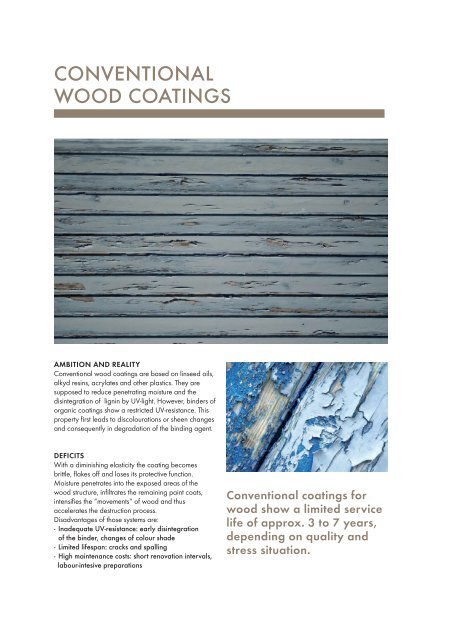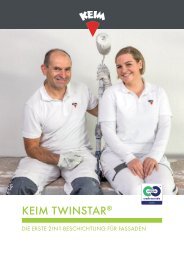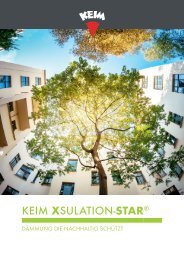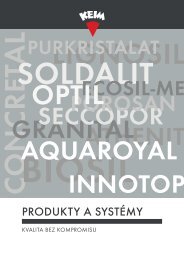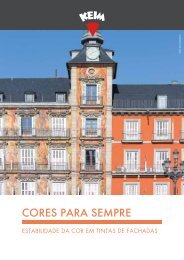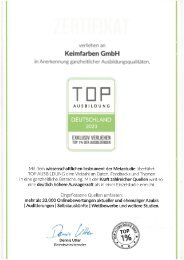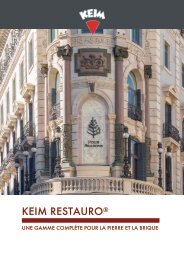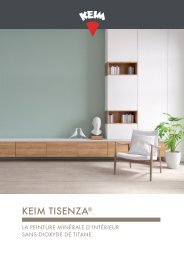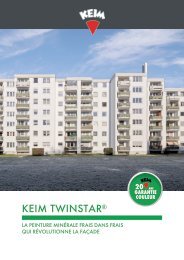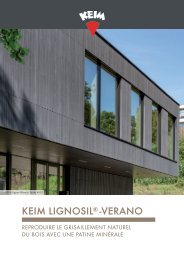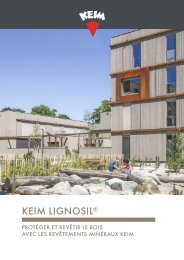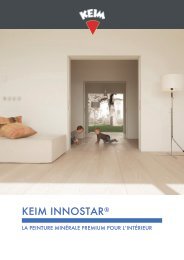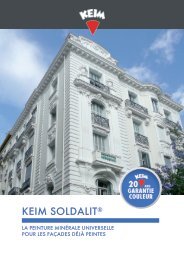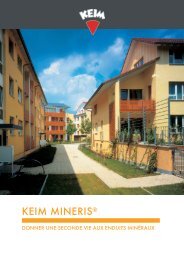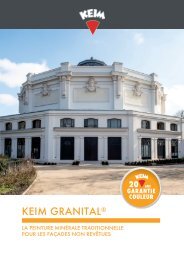Create successful ePaper yourself
Turn your PDF publications into a flip-book with our unique Google optimized e-Paper software.
k e i m lignosil ® – mineral p a i n t for w o o d<br />
7<br />
CONVENTIONAL<br />
WOOD COATINGS<br />
INNOVATIVE<br />
WOOD COATINGS<br />
VISION AND INNOVATION<br />
Manufacturers of common wood coatings constantly<br />
introduce innovation approaches and put new products<br />
on the market. However, always using the same<br />
organic basis so that typical disadvantages like limited<br />
UV-resistance and high maintenance costs continue to<br />
be accepted.<br />
The development of a silicate<br />
paint for the organic<br />
substrate of wood is a<br />
ground-braking progress in<br />
the quality of wood coatings!<br />
THE SILICATE PAINT PRINCIPLE<br />
Silicate paints consist of inorganic binding agents,<br />
mineral fillers and inorganic pigments. Curing takes<br />
place by means of a chemical reaction between the<br />
binding agent and mineral reaction partners in the<br />
substrate forming a chemical and unsoluble bond.<br />
Silicate paints have been proven highly weatherresistant<br />
and durable on mineral building materials.<br />
They are particularly suitable for maintenance,<br />
preservation and the design of facades thanks to their<br />
typical lime-matt appearance and purely inorganic<br />
pigmented colour shades.<br />
AMBITION AND REALITY<br />
Conventional wood coatings are based on linseed oils,<br />
alkyd resins, acrylates and other plastics. They are<br />
supposed to reduce penetrating moisture and the<br />
disintegration of lignin by UV-light. However, binders of<br />
organic coatings show a restricted UV-resistance. This<br />
property first leads to discolourations or sheen changes<br />
and consequently in degradation of the binding agent.<br />
DEFICITS<br />
With a diminishing elasticity the coating becomes<br />
brittle, flakes off and loses its protective function.<br />
Moisture penetrates into the exposed areas of the<br />
wood structure, infiltrates the remaining paint coats,<br />
intensifies the “movements“ of wood and thus<br />
accelerates the destruction process.<br />
Disadvantages of those systems are:<br />
- Inadequate UV-resistance: early disintegration<br />
of the binder, changes of colour shade<br />
- Limited lifespan: cracks and spalling<br />
- High maintenance costs: short renovation intervals,<br />
labour-intesive preparations<br />
Conventional coatings for<br />
wood show a limited service<br />
life of approx. 3 to 7 years,<br />
depending on quality and<br />
stress situation.<br />
EUREKA!<br />
After 20 years of research, the developers at <strong>KEIM</strong><br />
succeeded in transferring the “silicate paint model“ to<br />
the substrate of wood. Two proven coating materials<br />
are combined:<br />
– An oil primer with good penetration property and,<br />
– A silicate paint that protects reliably from<br />
weathering and exposure to UV-light.<br />
The result is <strong>KEIM</strong> <strong>Lignosil</strong> - the world‘s first mineral<br />
composite coating to protect wooden surfaces from<br />
weathering.


